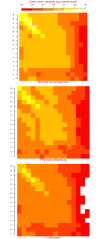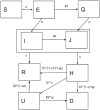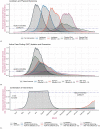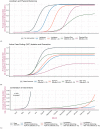COVID-19 control strategies and intervention effects in resource limited settings: A modeling study
- PMID: 34077483
- PMCID: PMC8172066
- DOI: 10.1371/journal.pone.0252570
COVID-19 control strategies and intervention effects in resource limited settings: A modeling study
Abstract
Introduction: Many countries with weaker health systems are struggling to put together a coherent strategy against the COVID-19 epidemic. We explored COVID-19 control strategies that could offer the greatest benefit in resource limited settings.
Methods: Using an age-structured SEIR model, we explored the effects of COVID-19 control interventions-a lockdown, physical distancing measures, and active case finding (testing and isolation, contact tracing and quarantine)-implemented individually and in combination to control a hypothetical COVID-19 epidemic in Kathmandu (population 2.6 million), Nepal.
Results: A month-long lockdown will delay peak demand for hospital beds by 36 days, as compared to a base scenario of no intervention (peak demand at 108 days (IQR 97-119); a 2 month long lockdown will delay it by 74 days, without any difference in annual mortality, or healthcare demand volume. Year-long physical distancing measures will reduce peak demand to 36% (IQR 23%-46%) and annual morality to 67% (IQR 48%-77%) of base scenario. Following a month long lockdown with ongoing physical distancing measures and an active case finding intervention that detects 5% of the daily infection burden could reduce projected morality and peak demand by more than 99%.
Conclusion: Limited resource settings are best served by a combination of early and aggressive case finding with ongoing physical distancing measures to control the COVID-19 epidemic. A lockdown may be helpful until combination interventions can be put in place but is unlikely to reduce annual mortality or healthcare demand.
Conflict of interest statement
The authors have declared that no competing interests exist.
Figures





Similar articles
-
Initial Assessment of the Impact of the Emergency State Lockdown Measures on the 1st Wave of the COVID-19 Epidemic in Portugal.Acta Med Port. 2020 Nov 2;33(11):733-741. doi: 10.20344/amp.14129. Epub 2020 Nov 2. Acta Med Port. 2020. PMID: 33160423
-
The effect of control measures on COVID-19 transmission in South Korea.PLoS One. 2021 Mar 29;16(3):e0249262. doi: 10.1371/journal.pone.0249262. eCollection 2021. PLoS One. 2021. PMID: 33780504 Free PMC article.
-
COVID-19 healthcare demand and mortality in Sweden in response to non-pharmaceutical mitigation and suppression scenarios.Int J Epidemiol. 2020 Oct 1;49(5):1443-1453. doi: 10.1093/ije/dyaa121. Int J Epidemiol. 2020. PMID: 32954400 Free PMC article.
-
Effectiveness of non-pharmaceutical public health interventions against COVID-19: A systematic review and meta-analysis.PLoS One. 2021 Nov 23;16(11):e0260371. doi: 10.1371/journal.pone.0260371. eCollection 2021. PLoS One. 2021. PMID: 34813628 Free PMC article.
-
Nonpharmaceutical interventions in Turkey and worldwide during COVID-19 pandemic.Turk J Med Sci. 2021 Dec 17;51(SI-1):3207-3214. doi: 10.3906/sag-2106-210. Turk J Med Sci. 2021. PMID: 34590802 Free PMC article. Review.
Cited by
-
A Review of Protein-Based COVID-19 Vaccines: From Monovalent to Multivalent Formulations.Vaccines (Basel). 2024 May 25;12(6):579. doi: 10.3390/vaccines12060579. Vaccines (Basel). 2024. PMID: 38932308 Free PMC article. Review.
-
Economic evaluation of strategies against coronavirus: a systematic review.Health Econ Rev. 2023 Mar 18;13(1):18. doi: 10.1186/s13561-023-00430-1. Health Econ Rev. 2023. PMID: 36933043 Free PMC article. Review.
-
Quarantine alone or in combination with other public health measures to control COVID-19: a rapid review.Cochrane Database Syst Rev. 2020 Sep 15;9(9):CD013574. doi: 10.1002/14651858.CD013574.pub2. Cochrane Database Syst Rev. 2020. PMID: 33959956 Free PMC article.
-
The Epidemiological and Economic Impact of COVID-19 in Kazakhstan: An Agent-Based Modeling.Healthcare (Basel). 2023 Nov 16;11(22):2968. doi: 10.3390/healthcare11222968. Healthcare (Basel). 2023. PMID: 37998460 Free PMC article.
-
Epidemiological characterization of COVID-19 in displaced populations of South Sudan.Pan Afr Med J. 2022 Jun 9;42(Suppl 1):4. doi: 10.11604/pamj.supp.2022.42.1.33767. eCollection 2022. Pan Afr Med J. 2022. PMID: 36158931 Free PMC article.
References
-
- World Health Organization. Coronavirus (COVID-19) events as they happen; 2020. Available from: https://www.who.int/emergencies/diseases/novel-coronavirus-2019/events-a....
-
- World Health Organization. Coronavirus disease (COVID-2019) situation reports; 2020. Available from: https://www.who.int/emergencies/diseases/novel-coronavirus-2019/situatio....
-
- Schafer H. COVID-19 will hit South Asia hard. We are fighting back; 2020. Available from: https://blogs.worldbank.org/endpovertyinsouthasia/covid-19-will-hit-sout....
MeSH terms
LinkOut - more resources
Full Text Sources
Medical

